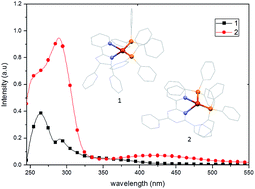Synthesis, structure, characterization and photophysical properties of copper(i) complexes containing polypyridyl ligands†
Abstract
Two novel photoluminescent copper(I) complexes having the compositions [CuI(L1)(PPh3)2]NO3·3CHCl3(1) and [CuI(L2)(PPh3)2]NO3·H2O(2) with PPh3 = triphenylphosphine, L1 = cis-(±)-2-(2,5-di(pyridin-2-yl)-4,5-dihydro-1H-imidazol-4-yl)pyridine and L2 = 2,4,6-tris(2-pyridyl)triazine have been successfully synthesized and characterized by IR and 1H-NMR spectroscopy, FAB+ mass spectrometry and single-crystal X-ray diffraction analysis. Both complexes showed interesting photophysical properties, which were studied experimentally in solution and in the solid state by UV-Vis and fluorescence spectroscopy and theoretically using TD-DFT calculations.


 Please wait while we load your content...
Please wait while we load your content...